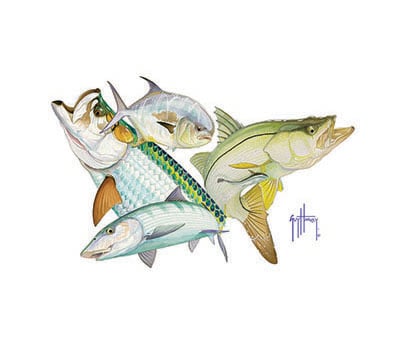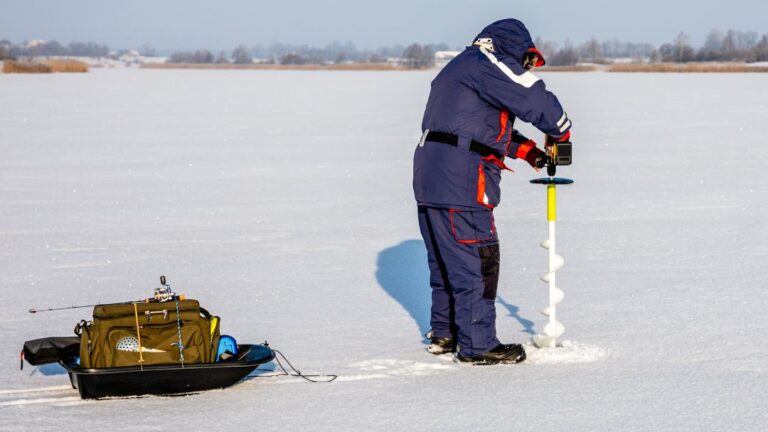Largemouth Bass Secrets: Unlock How to Identify and Master Catching Tips
Largemouth Bass is a popular fish species known for its distinguishable features and must-know tips for catching it. We will explore how to identify this species and provide valuable insights on effective techniques to catch them in their natural habitat.
So, let’s dive right in and discover everything you need to know about Largemouth Bass identification and fishing tips.
The Anatomy Of A Largemouth Bass
Largemouth bass, scientifically known as Micropterus salmoides, are one of the most sought-after game fish in North America. Understanding the anatomy of a largemouth bass is essential for any angler who wants to improve their fishing skills and increase their chances of catching this elusive species. In this section, we will explore the key physical features that help identify largemouth bass, their body structure, and how to differentiate them from other bass species.
Key Physical Features For Identifying Largemouth Bass
Largemouth bass possess several physical features that distinguish them from other bass species. By familiarizing yourself with these features, you can easily identify a largemouth bass:
- Size: Largemouth bass typically range in size from 12 to 24 inches, although they can grow larger under optimal conditions.
- Mouth: As the name suggests, largemouth bass have a large mouth that extends beyond the back edge of their eyes.
- Coloration: The coloration of largemouth bass can vary depending on their surroundings, but they commonly have a dark green to olive green back with a lighter belly. They also have a dark, horizontal stripe along their sides.
- Dorsal Fin: Largemouth bass have a single, elongated and spiny dorsal fin that runs along their back.
Understanding The Bass’s Body Structure And Characteristics
In addition to their physical features, understanding the body structure and unique characteristics of largemouth bass can greatly enhance your fishing experience:
- Body Shape: Largemouth bass have a robust and elongated body with a broad and flat head. Their body shape allows them to navigate through vegetation and ambush their prey.
- Gills and Gill Covers: The gills of a largemouth bass are located on either side of their head and are protected by gill covers. The gill covers have a hard bony plate, which helps differentiate them from other bass species.
- Lateral Line: Largemouth bass possess a lateral line, a visible line that runs horizontally along the sides of their body. This line helps them detect movement and vibrations in the water, aiding their predatory instincts.
- Spines: Largemouth bass have sharp spines on their dorsal, anal, and pelvic fins. These spines serve as a defense mechanism and can cause injury, so handling them with care is crucial.
How To Differentiate Largemouth Bass From Other Bass Species
While largemouth bass share some similarities with other bass species, there are distinct differences that can help you identify them:
| Bass Species | Distinctive Features |
|---|---|
| Smallmouth Bass | Smaller mouth, bronze to olive-brown color, vertical bars on their sides, red eyes. |
| Spotted Bass | Smaller mouth, prominent dark spots along the lower sides and belly, horizontal bars on their sides, red eyes. |
| Striped Bass | Distinct dark horizontal stripes along their sides, elongated body, toothed tongue, two dorsal fins. |
By paying attention to these distinctive features, you can ensure that you accurately differentiate largemouth bass from other bass species.
Seasonal Behavior And Habitat Preferences
Understanding the different behaviors of largemouth bass throughout the year is crucial for successfully targeting and catching these elusive fish. Largemouth bass have distinct seasonal behavior patterns and habitat preferences that can significantly impact their feeding habits and movements. In this section, we will explore how the behavior of largemouth bass changes throughout the year and how their habitat preferences determine their movements and feeding patterns.
Understanding The Different Behaviors Of Largemouth Bass Throughout The Year
Largemouth bass exhibit different behaviors depending on the time of year. Understanding these patterns can greatly increase your chances of catching them. Here is a breakdown of largemouth bass behavior throughout the year:
- Spring: During the spring months, largemouth bass become more active as the water temperature rises. They move into shallower areas of the water to spawn and feed. This is a prime time for anglers to target largemouth bass, as they are more willing to bite and are often found near structure or vegetation.
- Summer: In the summer, largemouth bass tend to retreat to deeper, cooler waters. They become less active during the hottest parts of the day and are more likely to be found near structures such as submerged trees, rocks, or drop-offs. Targeting these areas with slower and deeper presentations can yield great results.
- Fall: As the water temperature starts to cool down in the fall, largemouth bass become more active again and move closer to the shore. This is when they prepare for the upcoming winter by feeding heavily. Targeting areas with a mix of shallow and deep water near cover or structure can lead to successful catches.
- Winter: Winter is the most challenging season to catch largemouth bass, as they become less active and seek out warmer pockets of water. They tend to move into deeper areas with less current, such as deep holes or the mouths of creeks. Slow presentations and patience are key during this time of year.
How The Bass’s Habitat Preferences Change With The Seasons
Largemouth bass also have specific habitat preferences that change with the seasons. These preferences dictate their movements and can help you narrow down your search for these fish:
| Season | Habitat Preference |
|---|---|
| Spring | Shallow water with structure or vegetation where they can spawn and feed |
| Summer | Deeper water with structures such as submerged trees, rocks, or drop-offs for cooler temperatures |
| Fall | Areas with a mix of shallow and deep water near cover or structure to feed and prepare for winter |
| Winter | Deeper areas with less current, such as deep holes or the mouths of creeks for warmer water |
Tips For Finding And Targeting Bass Based On Their Seasonal Patterns
Now that you have an understanding of the seasonal behavior and habitat preferences of largemouth bass, here are some tips to help you find and successfully target them:
- Pay close attention to water temperature, as it directly affects the activity level of largemouth bass.
- Use a variety of lures and presentations to mimic the prey they are targeting during each season.
- Focus on areas with structure such as submerged trees, rocks, or aquatic vegetation, as largemouth bass often seek cover and ambush their prey.
- Experiment with different depths and retrieve speeds to determine the feeding patterns of the bass on that particular day.
- Keep an eye out for signs of baitfish activity, as largemouth bass are often found near areas with an abundance of prey.
- Consider using live bait, such as worms or minnows, as they can be highly effective in enticing bass to bite.
- Stay persistent and patient, as largemouth bass can be finicky and may require multiple attempts before getting a strike.
By understanding the seasonal behavior and habitat preferences of largemouth bass, you can significantly increase your chances of landing a trophy catch. So, gear up, head out to the water, and put your newfound knowledge to the test!
Essential Gear And Tackle For Largemouth Bass Fishing
Fishing for largemouth bass can be an exhilarating and rewarding experience. To ensure a successful fishing trip, it is essential to have the right gear and tackle. In this section, we will discuss the must-have equipment, how to choose the right fishing rods, reels, and lines, as well as the different types of lures and baits that work best for catching largemouth bass.
A Comprehensive List Of Must-have Gear For Successful Bass Fishing
When it comes to largemouth bass fishing, having the right gear is crucial. Below is a comprehensive list of the essential equipment you will need for a successful bass fishing expedition:
| Item | Description |
|---|---|
| Fishing Rods | The fishing rod should be medium to heavy action with a length of around 6 to 7 feet. |
| Fishing Reels | Opt for baitcasting or spinning reels that are suitable for bass fishing. |
| Fishing Line | Use a monofilament or fluorocarbon fishing line with a pound test suitable for fishing in different conditions. |
| Tackle Box | A tackle box to store all your hooks, sinkers, lures, and other fishing accessories. |
| Hooks | Wide-gap worm hooks, offset hooks, and treble hooks of various sizes. |
| Sinkers | Different sized bullet weights, drop shot sinkers, and split shot sinkers. |
| Soft Plastic Lures | Choose a variety of soft plastic lures, such as worms, creature baits, and crawfish imitations. |
| Hard Baits | Include crankbaits, topwater lures, and jerkbaits in your tackle box for different fishing conditions. |
| Spinnerbaits | Spinnerbaits with different blade designs and colors to attract bass. |
| Jigs | Football jigs, flipping jigs, and swim jigs of various weights. |
| Leaders and Swivels | Leaders made of fluorocarbon or braided fishing line, along with swivels to prevent line twist. |
| Pliers and Scissors | Tools to remove hooks, cut lines, and make necessary adjustments on the go. |
Choosing The Right Fishing Rods, Reels, And Lines For Largemouth Bass
When it comes to selecting fishing rods, reels, and lines for largemouth bass fishing, it’s essential to consider a few factors. Firstly, opt for a fishing rod with a medium to heavy action. This type of rod offers the strength and flexibility required to handle a largemouth bass. Additionally, the length should be around 6 to 7 feet for better control and accuracy in casting.
Baitcasting or spinning reels are commonly used for bass fishing. Depending on your preference and skill level, choose a reel that suits your needs. Baitcasting reels offer better casting accuracy and control, while spinning reels are user-friendly and suitable for beginners.
When it comes to fishing lines, monofilament or fluorocarbon lines are popular choices. Monofilament lines are cost-effective, easy to handle, and have good strength. Fluorocarbon lines, on the other hand, are virtually invisible underwater, making them a great choice for clearer waters. Choose a pound test based on the fishing conditions you will be facing.
Different Types Of Lures And Baits That Work Best For Bass Fishing
Largemouth bass have a diverse palate, and using the right lure or bait is essential to attract their attention. Here are the different types of lures and baits that work best for bass fishing:
- Soft Plastic Lures: Worms, creature baits, and crawfish imitations are highly effective in enticing bass.
- Hard Baits: Crankbaits, topwater lures, and jerkbaits can mimic the movement of natural prey, attracting bass from a distance.
- Spinnerbaits: These lures with spinning blades create vibrations in the water, enticing bass to strike.
- Jigs: Football jigs, flipping jigs, and swim jigs are great for targeting bass in different depths and structures.
By having a diverse selection of lures and baits, you increase your chances of success in different fishing conditions and locations.
Techniques And Strategies For Catching Largemouth Bass
Mastering different fishing techniques for bass is essential for any angler looking to reel in a prized largemouth bass. By understanding the various strategies and techniques, you can increase your chances of a successful catch. In this section, we’ll explore some of the top techniques, tips for lure selection, and insights into the bass’s feeding habits.
Mastering Different Fishing Techniques For Bass, Including Topwater, Jigging, And Flipping
When it comes to bass fishing, understanding and practicing different fishing techniques can make a world of difference in your success rate. Below, we’ll take a closer look at three popular techniques: topwater, jigging, and flipping.
| Technique | Description |
|---|---|
| Topwater | Fishing with topwater lures that imitate prey on the water’s surface. This technique can elicit explosive strikes from aggressive largemouth bass. Cast the lure near cover or structure, then retrieve it with a steady and rhythmic motion to entice the bass to strike. |
| Jigging | Using a jig and trailer combination to mimic a crawfish or baitfish. Cast the jig near structure or cover and let it sink to the desired depth. Then, impart a series of short, sharp movements to make the jig hop off the bottom. This imitates a struggling prey and can trigger a reaction bite from the bass. |
| Flipping | A technique where you pitch or toss a bait into tight, heavy cover where bass are likely hiding. Use a heavy line and rod for better control and accuracy. Allow the bait to sink, then lift it with a smooth motion and let it fall back into the cover. Repeat this process to entice a lurking bass to bite. |
Tips For Effectively Using Specific Lures And Baits To Attract Largemouth Bass
Selecting the right lure or bait is crucial for attracting largemouth bass. Each type of lure has its own unique action and presentation that can entice bass to strike. Here are some tips for effectively using specific lures and baits:
- Crankbaits: Use crankbaits with a diving lip to imitate wounded baitfish. Vary the retrieve speed to find what the bass prefer.
- Soft Plastic Worms: Rig a plastic worm Texas style or Carolina rig to present it weedless. Experiment with different colors and sizes to find the one that works best on that day.
- Spinnerbaits: Choose spinnerbaits with willow or Colorado blades to create flash and vibration. Retrieve at varying speeds to mimic different prey.
- Swimbaits: Select swimbaits that match the size and color of the baitfish in the area. Use a slow and steady retrieve to imitate a swimming prey.
Understanding The Bass’s Feeding Habits And Adjusting Your Approach Accordingly
Understanding the feeding habits of largemouth bass is key to a successful fishing trip. Bass are opportunistic predators and can change their preferences depending on various factors. Here are some insights into their feeding habits:
- Time of Day: Bass are often most active during low light conditions, such as early morning or late evening. Adjust your fishing schedule accordingly.
- Seasonal Patterns: Bass may exhibit different feeding behaviors during different seasons. In colder months, they may prefer slower-moving presentations, while in warmer months, they may be more aggressive.
- Preferred Prey: Bass commonly prey on baitfish, crawfish, and other small aquatic creatures. Use lures or baits that resemble their preferred prey to increase your chances of a bite.
- Water Temperature: Bass are sensitive to water temperature. In colder water, they tend to be less active, while warmer water may trigger more aggressive feeding behavior.
By understanding these feeding habits and adjusting your approach accordingly, you can increase your chances of a successful bass catch.
Best Practices For Catch And Release
Catch and release is not only a responsible angling practice but also crucial for the conservation of largemouth bass populations. By understanding and implementing proper handling techniques, you can ensure the survival and well-being of released fish. In this section, we will explore the importance of catch and release in preserving largemouth bass populations, as well as provide tips on how to properly handle and release these magnificent fish.
The Importance Of Practicing Catch And Release To Conserve Largemouth Bass Populations
Largemouth bass populations play a vital role in maintaining the balance of freshwater ecosystems. By practicing catch and release, you contribute to the sustainability of these populations and ensure future generations can enjoy the thrill of bass fishing. Here are some key reasons why catch and release is essential:
- Preserve breeding stock: Large, older bass are often the primary contributors to the next generation of bass. Releasing them allows them to continue breeding and maintaining genetic diversity within the population.
- Maintain population balance: Healthy bass populations contribute to ecological balance in aquatic ecosystems, maintaining prey-predator relationships and overall biodiversity.
- Promote natural growth: By releasing smaller bass, you give them the opportunity to grow and mature, eventually reaching their maximum potential size.
Proper Handling Techniques To Ensure The Survival Of Released Fish
The way you handle largemouth bass during catch and release greatly impacts their chances of survival. Here are some best practices to follow:
- Minimize air exposure: Keep the fish in the water as much as possible, avoiding excessive air exposure. Bass have delicate gill structures, and prolonged exposure to air can harm their respiratory system.
- Use appropriate gear: Equip yourself with a landing net, long-nose pliers, and a hook-removal tool to minimize handling time and reduce stress on the fish.
- Handle with wet hands or gloves: Wet your hands or wear gloves to prevent the removal of the fish’s protective slime layer. This slime provides defense against infections and parasites.
- Support the fish: When lifting the fish, support its body horizontally, avoiding excessive pressure on the belly. Cradling the bass and providing gentle support helps minimize the risk of internal injuries.
Tips For Minimizing Stress On Bass During The Catch And Release Process
To ensure the well-being and survival of released largemouth bass, it is crucial to minimize stress during the catch and release process. These tips will assist in reducing stress levels:
- Landing the fish quickly: The longer the fight, the more exhausted the fish becomes. Minimize the fight time by using appropriate fishing gear and techniques.
- Using barbless hooks: Barbless hooks are easier to remove, decreasing handling time and lowering the risk of injuries to the fish.
- Avoiding excessive handling: Handle the fish gently and only as necessary. Excessive handling can damage its delicate fins and scales, potentially leading to infections.
- Revive before release: If the fish appears tired during the release, gently hold it underwater, allowing water to flow over its gills. This will help revive the bass before it swims away.
By adhering to these best practices and adopting a catch and release mindset, you can contribute to the long-term conservation of largemouth bass populations while enjoying the thrill of the sport.
Conclusion
To wrap up, correctly identifying a largemouth bass is essential for any angler. By understanding its distinct characteristics and behavior, such as its large mouth, dark lateral line, and aggressive feeding habits, you can increase your chances of successfully catching this sought-after species.
Remember to use the tips provided, such as choosing the right equipment, using the proper fishing techniques, and varying your bait selection. So next time you head out for a fishing adventure, keep these guidelines in mind to ensure a productive and exciting largemouth bass fishing experience.
Happy fishing!




